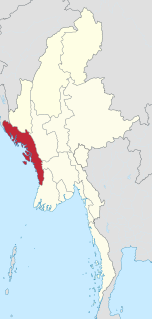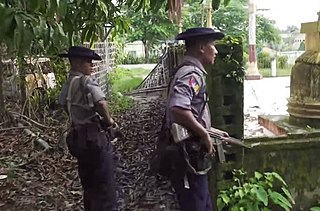Rohingya persecution in Myanmar refers to a recurring pattern of persecution of the Rohingya people, a largely Muslim group in Myanmar.
Persecution is the systematic mistreatment of an individual or group by another individual or group. The most common forms are religious persecution, racism and political persecution, though there is naturally some overlap between these terms. The inflicting of suffering, harassment, imprisonment, internment, fear, or pain are all factors that may establish persecution, but not all suffering will necessarily establish persecution. The suffering experienced by the victim must be sufficiently severe. The threshold level of severity has been a source of much debate.

The Rohingya people are a stateless Indo-Aryan ethnic group who reside in Rakhine State, Myanmar. There were an estimated 1 million Rohingya living in Myanmar before the 2016–17 crisis. By December 2017, an estimated 625,000 refugees from Rakhine, Myanmar, had crossed the border into Bangladesh since August 2017. The majority are Muslim while a minority are Hindu. Described by the United Nations in 2013 as one of the most persecuted minorities in the world, the Rohingya population is denied citizenship under the 1982 Myanmar nationality law. According to Human Rights Watch, the 1982 laws "effectively deny to the Rohingya the possibility of acquiring a nationality". Although Rohingya history in the region can be traced back to the 8th century, Myanmar law does not recognize the ethnic minority as one of the eight "national indigenous races". They are also restricted from freedom of movement, state education and civil service jobs. The legal conditions faced by the Rohingya in Myanmar have been widely compared to apartheid by many international academics, analysts and political figures, including Nobel laureate Bishop Desmond Tutu, a South African anti-apartheid activist.

Myanmar, officially the Republic of the Union of Myanmar, and also known as Burma, is a country in Southeast Asia. Myanmar is bordered by India and Bangladesh to its west, Thailand and Laos to its east and China to its north and northeast. Myanmar is the largest of the mainland Southeast Asian states. To its south, about one third of Myanmar's total perimeter of 5,876 km (3,651 mi) forms an uninterrupted coastline of 1,930 km (1,200 mi) along the Bay of Bengal and the Andaman Sea. The country's 2014 census counted the population to be 51 million people. As of 2017, the population is about 54 million. Myanmar is 676,578 square kilometres in size. Its capital city is Naypyidaw, and its largest city is Yangon (Rangoon). Myanmar has been a member of the Association of Southeast Asian Nations (ASEAN) since 1997.
Examples include:
- Rohingya conflict, a series of ongoing violent clashes in northern Rakhine State, Myanmar
- Arakan massacres in 1942, commonly regarded as the event that started the conflict.
- 2015 Rohingya refugee crisis, a mass migration of Rohingya people from Myanmar and Bangladesh, due in part to the conflict.
- 2016 Rohingya persecution in Myanmar
- 2017 Rohingya persecution in Myanmar, which included:
- Gu Dar Pyin massacre, Massacre of Rohingya people by the Myanmar Army on 27 August 2017
- Inn Din massacre, Massacre of Rohingya people by the Myanmar Army on 30 August 2017
- Tula Toli massacre, Massacre of Rohingya people by the Myanmar Army on 2 September 2017
The Gu Dar Pyin massacre was a mass-killing of Rohingya people by the Myanmar Army and armed Rakhine locals that reportedly happened in the village of Gu Dar Pyin, in Rakhine State, Myanmar on 27 August 2017. According to eyewitness testimony and video evidence first reported by the Associated Press, victims of the massacre were buried in five mass graves by the Myanmar Army and burnt with acid. Rohingya village elders recorded a list of 75 people who may have died in the massacre, whilst locals estimate that up to 400 people were killed in the massacre.

The Inn Din massacre was a mass execution of Rohingyas by the Myanmar Army and armed Rakhine locals in the village of Inn Din, in Rakhine State, Myanmar on 2 September 2017. The victims were accused of being members of the Arakan Rohingya Salvation Army (ARSA) by authorities. An investigation by Myanmar's military concluded on 10 January 2018 that there was indeed a mass execution of Rohingyas in Inn Din, marking the first instance where the military admitted to extrajudicial killings during their "clearance operations" in the region.
The Tula Toli massacre was a mass-killing of Rohingya people that purportedly occurred during a Myanmar Army clearance operation in the village of Tula Toli, Rakhine State, near the Bangladesh–Myanmar border. According to eyewitnesses, Burmese soldiers allegedly carried out the massacre with the support of local Rakhines who also resided in the village. Eyewitnesses claim that at least 200 women and 300 children were killed; however, this has not been verified and there is no official estimate.

The Rohingya conflict is an ongoing conflict in the northern part of Myanmar's Rakhine State, characterised by sectarian violence between the Rohingya Muslim and Rakhine Buddhist communities, a military crackdown on Rohingya civilians by Myanmar's security forces, and militant attacks by Rohingya insurgents in Buthidaung, Maungdaw, and Rathedaung Townships, which border Bangladesh.
During World War II, Japanese forces invaded Burma, that was then under British colonial rule. The British forces retreated and in the power vacuum left behind, considerable inter communal violence erupted between Pro-Japanese Buddhist Rakhine and Pro-British Muslim villagers. As part of the 'stay-behind' strategy to impede the Japanese advance, the Commander-in-Chief of forces in Delhi, Wavell, established "V-Force" which armed Rohingya locals in northern Arakan to create a buffer zone from Japanese invasion when they retreated.
The 2015 Rohingya refugee crisis refers to the mass migration of people from Myanmar in 2015, collectively dubbed "boat people" by international media. Nearly all who fled traveled to Southeast Asian countries including Bangladesh, Malaysia, Indonesia and Thailand by rickety boats via the waters of the Strait of Malacca and the Andaman Sea.



